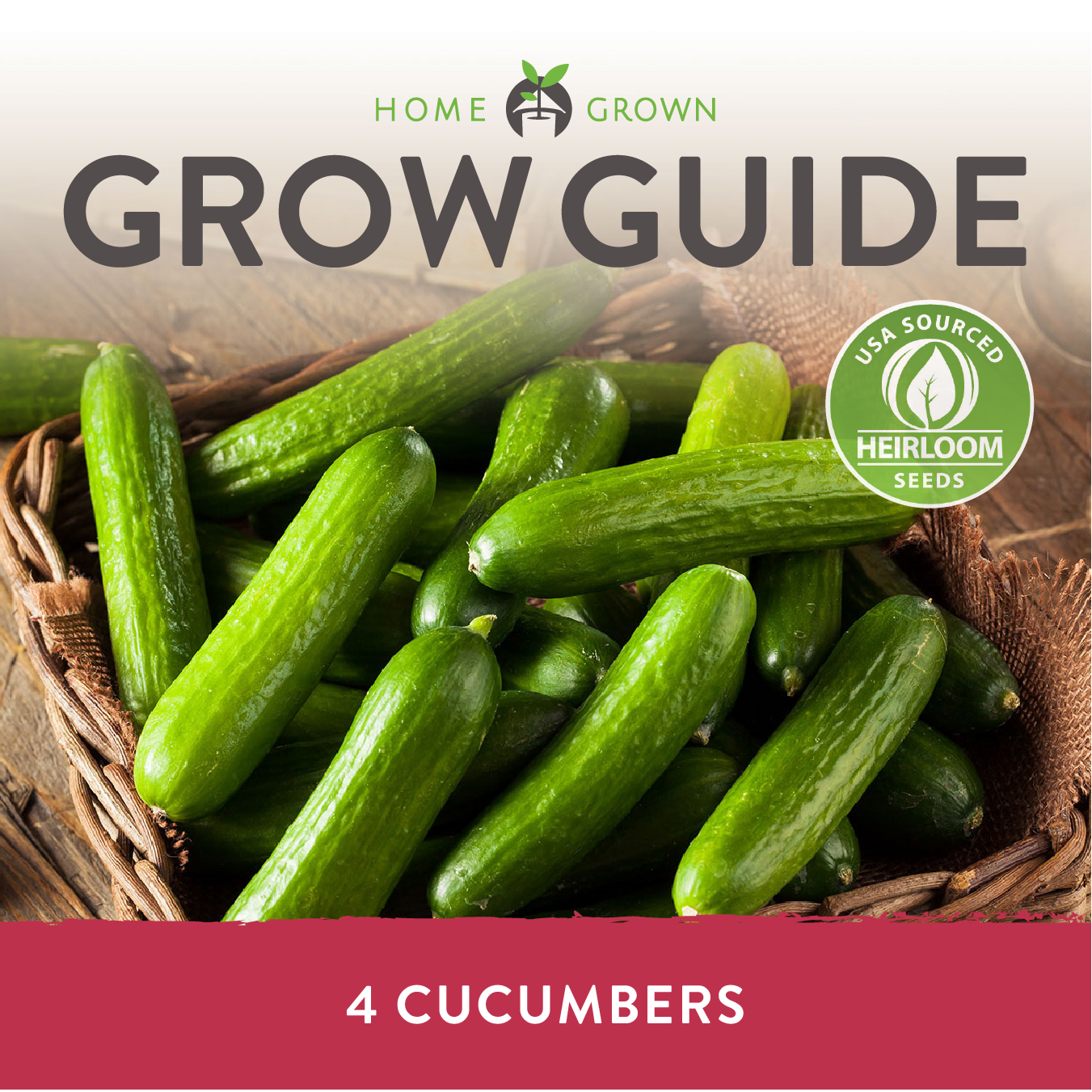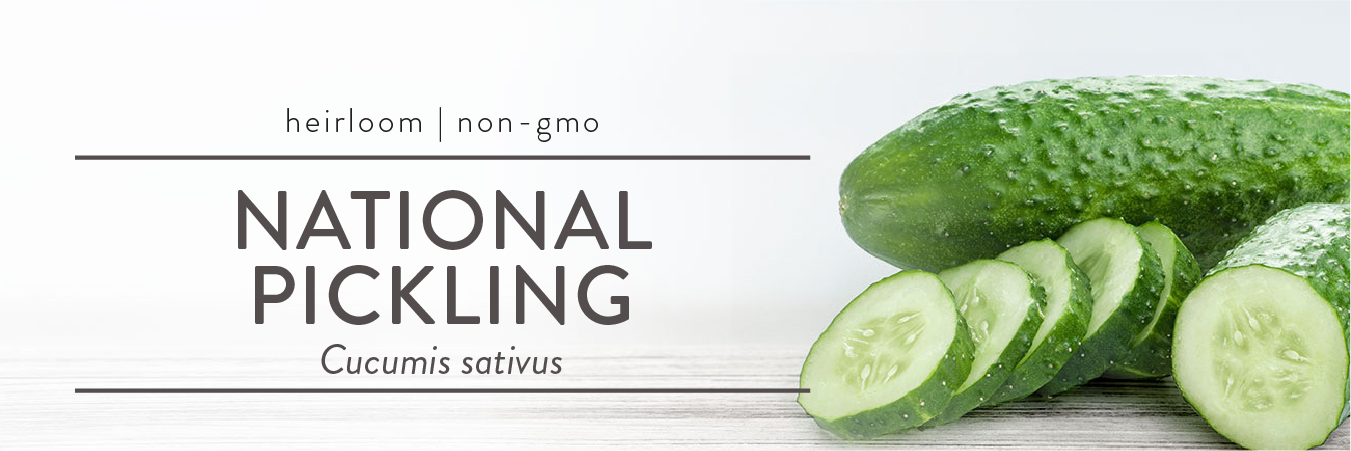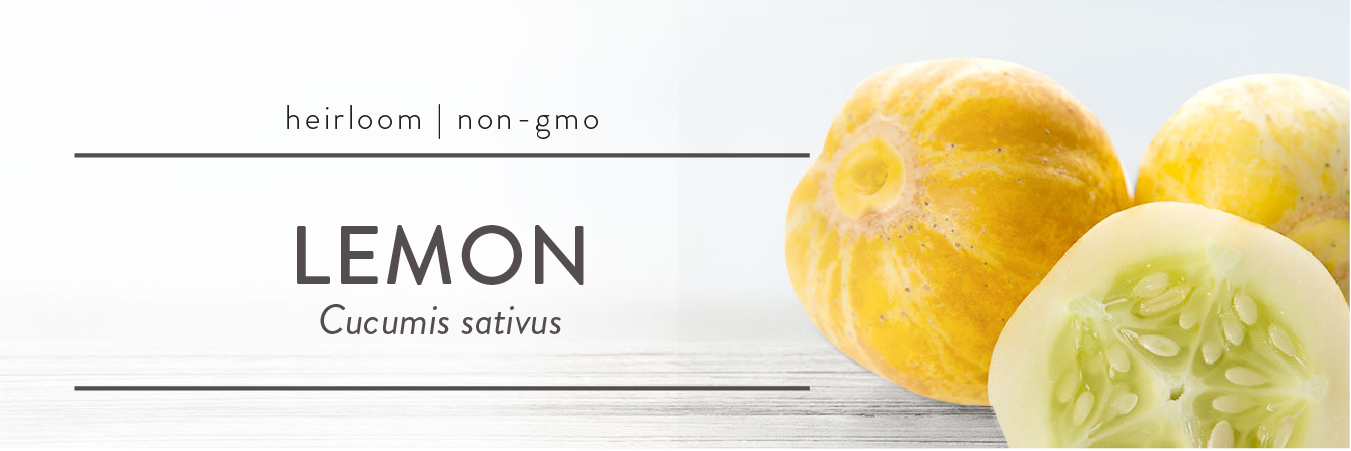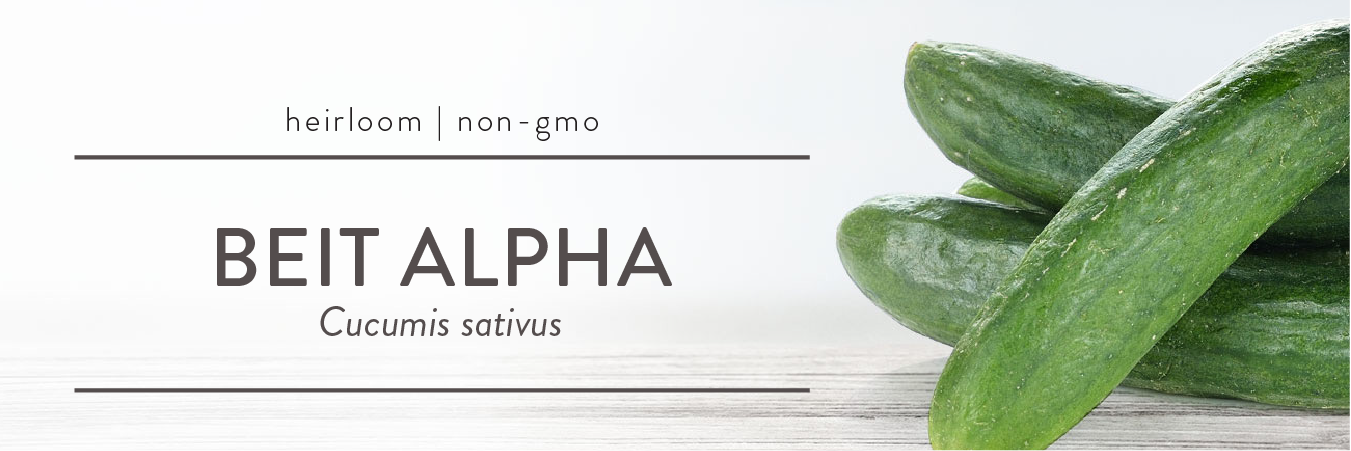
Home Grown is a small family-owned company with a love for gardening. From our own backyard, we have cultivated a passion for gardening that we want to share. We believe that it should be accessible to everyone, fun, and easy to start. Our goal at Home Grown is to provide you with the best quality products and services. Our team has spent years sourcing and creating products that help everyone from beginner to experienced gardeners alike.
We made sure that no green thumb is required to help you have your dream of gardening come true by providing you detailed instructions and guides which are included in all of our seed packs and kits. We hope you experience the same joy we have found for gardening.

This pack includes 4 varieties of the following seeds,
sealed in premium packets: Armenian Pale Green,
National Pickling, Lemon, and Beit Alpha cucumbers.
Start your own cucumber garden for fresh picks to
add to homemade meals, or give as a gift to fellow
green-thumb folks.
Cucumber seeds should be started indoors in areas with a short growing season. In areas with a longer growing season and mild winters, cucumber seeds can be sown directly into the garden. Plant your cucumbers in full-sun positions
and give them good, fertile soil rich in organic matter. Cucumbers are vining plants, they require some kind of support (trellis, mesh, pergola) in order to grow healthy and bring high yield.
Before you start planting your cucumber seeds, take a look at these useful growing tips!
Before transplanting your indoor-grown plants, be sure to “harden them off” to avoid transplant shock. Start the process a week or two before the planned transplanting date. Begin with placing the seedlings in a shady outdoor location for one hour the first day and gradually increasing the exposure time for the next few days.
After 3 or 4 days, you can introduce the seedlings to direct sunlight gradually, starting with just one hour per day and adding an hour each day until they can spend 6 hours per day in direct sunlight. This way, the tender seedlings will have time to adapt to outdoor growing conditions.
If starting indoors, try to use biodegradable planters to avoid root disturbance. Cucumbers have sensitive roots and need to be transplanted very carefully.

Not a true cucumber, but a muskmelon, this amazing plant produces long, pale green fruit that resembles a cucumber and offers a very similar taste. Also known as the burpless cucumber, the Armenian Pale Green variety
stands out with its yellow-green color and thin, tender skin that does not need to be peeled. It has a mild flavor and it never turns bitter. As it grows, this fruit twists and turns on the ground but hangs fairly straight when
grown on a trellis. Growing it on a trellis will keep the fruit straight, but will also maximize your garden space. The Armenian Pale Green cucumber is a heat-loving variety that grows best in humid climates and it’s prized for its
drought tolerance.
In areas with a short growing season, Armenian cucumber is best started indoors. The seeds can be sown approximately 4 to 6 weeks before the last spring frost. Use a seed starting soil mix and preferably biodegradable pots, as this type of plant has very fragile roots. By using a biodegradable pot you will avoid disturbing the
roots during transplanting. The seeds need warmth to germinate, so you may also use a heating mat to speed up
the germination indoors. The optimum soil temperature for germination is 70°F to 90°F, while the minimum soil temperature is 60°F. Sow several seeds per pot, at the depth of 1/2 inch—the number of seeds will depend on the
size of the pot, just be sure to space them 1/2 to 1 inch apart. Keep the soil moist, but not wet. When seeds sprout,
give them at least 6 hours of bright light on a sunny windowsill or under artificial grow lights. When sprouts are
2 to 3 inches tall, thin them to one plant per pot; try to leave the one that looks strongest.
Armenian Pale Green cucumbers need to be hardened for a week or two before being transferred to an outdoor garden. The best time to transplant them outside is when the danger of frost has passed. Choose a site in full sun and work the soil. Dig holes for pots and transplant them together with undisturbed seedlings at the base of a trellis or a support stand, spaced 12 to 24 inches apart. Armenian pale green cucumbers are extremely heat-tolerant but benefit from regular watering.
To directly sow seeds outdoors, wait for the last frost date to finish and the soil to warm up to 65°F. The ideal time for transplanting is somewhere around 2 to 3 weeks after the last spring frost. Choose a sunny location to dig a couple of inches of soil compost before sowing. Sow the seeds directly at the base of a trellis or fence. Sow 2 to 3 seeds 6 inches apart, preferably at the depth of 1/2 inch to 1 inch. Water the garden area regularly. When sprouts develop 3 to 4 leaves, you can thin them to 12 to 24 inches apart.
Armenian cucumber can be successfully grown in containers as well. You can use thinnings and plant them in containers if you’d like to grow more plants. Install support and give your plants a steady supply of water.
Pick fruit regularly to encourage the plant to produce more. Snip off the fruit from the vine, rather than pulling—this way you’ll avoid damaging the plant. National Pickling cucumbers can be harvested once they reach 2 to 3 inches in length for making gherkin pickles, though the larger cucumbers are equally good when pickled. If harvested at about 4 to 5 inches in length, they can be eaten fresh and added to meals such as sandwiches or salads.

As its name suggests, the National Pickling cucumber is one of the best varieties for pickling. The seeds grow high-yield vines that produce an abundance of crispy, dark green cucumbers with exceptionally tender skin.
They can hold their quality for longer periods of time but are most flavorful when young. National Pickling is a vining variety that’s best grown vertically against some kind of support. In addition, this variety is resistant to powdery mildew and mosaic viruses.
If you live in an area with a short growing season, it’s recommended to start your cucumber seeds indoors to get an early start. When sowing indoors, start 3 to 4 weeks before the last frost. It is advisable to sow the seeds into individual peat pots to reduce root damage during transplant. Fill the pots with a well-drained, seed starting
soil mixture. You can sow 2 to 3 seeds per pot, about 1/2 inch deep. Keep the soil medium evenly moist and try to maintain the soil temperature of around 70°F to 85°F. When seedlings emerge, provide them with plenty of sunlight, and once they’ve grown 2 to 3 inches tall, thin them and leave only one seedling per pot.
Consider transplanting your cucumber seedlings outdoors once the danger of frost is gone. By this time, they should be 3 to 6 inches tall. Prior to transplanting, be sure to harden off your seedlings for a week or two. The air temperature of around 65°F to 75°F is generally considered safe for transplanting young cucumber plants. Dig holes spaced 12 to 18 inches apart and make sure they’re deep enough so you could fit an entire peat pot in, together with a cucumber plant. Water regularly after transplanting and be sure to stake your plants or grow them against a trellis or a mesh.
In areas with a longer growing season, cucumber seeds can be sown directly into the garden. Wait until the soil has warmed up to 70°F to achieve a higher germination rate. Prepare a full-sun garden bed filled with well-drained, fertile soil. Sow 2 to 3 seeds every 6 inches, at the depth of 1/2 inch to 1 inch. Water thoroughly, but gently. When they grow 2 to 3 inches tall, thin them to 12 to 18 inches. It is advisable to use a trellis for cucumbers as they grow better when
allowed to climb.
Pick fruit regularly to encourage the plant to produce more. Snip off the fruit from the vine, rather than pulling—this way you’ll avoid damaging the plant. National Pickling cucumbers can be harvested once they reach 2 to 3 inches in length for making gherkin pickles, though the larger cucumbers are equally good when pickled. If harvested at about 4 to 5 inches in length, they can be eaten fresh and added to meals such as sandwiches or salads.

The Lemon cucumber is an unusual variety with rounded, lemon-like fruit that lacks the bitterness characteristic of most the cucumber varieties. The flavor is mild and sweet (not like lemon!), and the texture is crispy and juicy at the same time. The fruit ripens a little later than other cucumber varieties, but it also continues producing when other varieties have ended their
lifecycle. It’s a semi-bush type of cucumber that’s perfect for cooler climates, but it doesn’t tolerate frost.
Start your Lemon cucumber seeds indoors in spring, approximately 3 to 4 weeks before the last expected frost in your area. Use a seed starting tray (preferably made of peat) filled with seed starting pot soil and plant 2 to 3 seeds per cell. They should be planted at the depth of 1/2 inch. Water the seeds and keep the tray in a bright, warm spot. Maintain steady soil moisture. For successful germination, the soil temperature must be at least 60°F, though the optimal temperature ranges between 70°F and 80°F. To achieve this temperature, use heat mats if needed. When the seeds have sprouted, provide them with at least 8 hours of bright light per day.
When all danger of frost has passed and the soil is warm enough, you can transplant your cucumber seedlings outside. Before transplanting the seedlings, be sure to install adequate support (trellis or fence). Thin your seedlings and remove the weak ones. If you’ve planted your seeds in peat trays, leave only one plant per cell. Harden off your plants before moving them outdoors. Plant them in well-drained soil, amended with compost or manure. They should be planted 12 to 18 inches apart. Put the transplants deeper than they were in pots to promote a steady and strong stem. Water thoroughly after planting and keep them well-watered throughout the entire growing season. Mulch the area and fertilize occasionally.
In mild areas with a long growing season, you can direct-seed cucumbers in early spring when the soil is warm enough (at least 60°F) and there’s no longer any risk of frost. Loosen the soil and amend it with garden compost or well-rotted manure. Plant several seeds in 1-inch-deep holes (deeper than when sowing indoors) approximately 12 to 18 inches apart. Keep the area well-watered.
The more you harvest your Lemon cucumber, the more it will produce. The fruit is ready for harvest once it turns bright yellow. To harvest the fruit, twist it gently to avoid damaging the vine. Pick the fruit when it’s large enough (the size of a lime), but don’t let it get oversized. This variety is perfect for snacking, salads, or sandwiches. It’s delicious when eaten fresh, but it makes a great choice for pickling, as well as for detox water.

Beit Alpha is an extremely popular heirloom variety, prized for its sweetness and smooth skin that doesn’t need to be peeled. These burpless and spineless cucumbers with very few seeds are produced throughout the
extended fruiting season. Bred in Israel and extremely popular in the Mediterranean, Beit Alpha cucumbers are also called Lebanese cucumbers or Middle Eastern cucumbers. This amazing, high-yielding variety can be grown in greenhouses without pollinators, as it’s bred to set fruit even when the flowers are not pollinated. It’s easily trellised.
If you wish to get an early start for your cucumber plants, you can begin sowing indoors 3 to 4 weeks before the last spring frost. Fill a peat starting tray with well-drained, seed starting soil and sow 2 to 3 seeds in each cell. Water thoroughly and keep the soil evenly moist throughout the entire germination process. Cucumber seeds need warmth to germinate so make sure that the soil temperature is anywhere between 70°F to 85°F. It may take 2 weeks to germinate the seeds at 60°F, but only 3 days at 85°F. When your seeds sprout, give them plenty of light on a sunny windowsill or use artificial grow lights if needed.
After the danger of frost has passed, you can safely transplant your cucumber seedlings outside. The soil temperature should be at least 65°F. Before transplanting them outside, harden them off for a week or two, and then carefully thin the seedlings (leaving only one plant per pot). When the seedlings are fully adapted to outdoor growing conditions, rake the soil, remove the weeds, and amend the soil with plenty of organic matter to feed your cucumbers throughout the growing season.
Plant the seedlings in rows, spacing them 12 to 18 inches apart. Be sure to dig the hole twice the size of the rootball. Install support and water your cucumber plants regularly.
Direct-sow your cucumber seeds in spring after the last frost or when the soil temperature is over 70°F. Find a full-sun position, form a row and sow 2 to 3 seeds every 6 to 8 inches. Keep the area constantly moist, but not wet. When the seedlings have grown 3 to 4 inches tall, thin them to 12 to 18 inches apart. As they grow, you will need to tie them up to their support system. Water them abundantly, particularly during dry periods.
Beit Alpha cucumbers can grow up to 12 inches long, but they taste the best when picked at 4 to 5 inches. To harvest the fruit, snip off the stem with a sharp knife to avoid damaging the vine. Harvest regularly to promote the continuous production of fruit. Don’t leave mature fruit on the vine, as this will stunt the fruit production. Beit Alpha cucumbers are great for slicing, as well as for pickling when harvested while still small. These crispy cucumbers can be used in
salads, sandwiches, and many other meals.